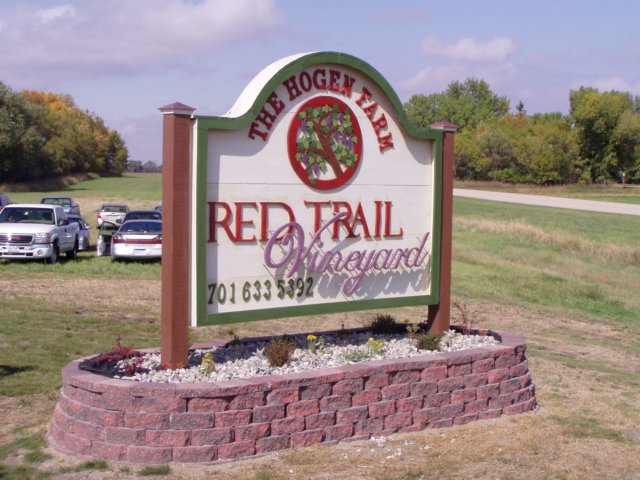All About The Red Trail Vineyard...
The Red Trail Vineyard is named after the historically significant Old Red Trail, one of the first established routes for automobile travel through the northern part of the United States. It stretched from Seattle, WA to New York, NY and passed just on the north side of the Vineyard. Through the years, many Native American artifacts have been found near the Vineyard and along the Old Red Trail, some of which are on display in the Tasting Room at Red Trail Vineyard. The Vineyard estate is bordered on the west and the south by Buffalo Creek, and is 200 feet above the Maple River Valley. The area is surrounded by trees, some old and some new, and is sloped slightly to the south.
Beginning in the 1880’s the Northern Pacific railroad provided consistent and reliable freight and passenger service, through the Dakota’s. In 1912, the American Automobile Association (AAA) sponsored a pathfinding expedition to identify a convenient route across the northern tier of states for auto travel between New York and Seattle. The route followed through North Dakota and closely paralleled the Northern Pacific Railway mainline.
In 1914, the AAA marked or blazed the route of the Red Trail. The marking of the trail was typically little more than a dash of red paint on a fence post or telephone pole, or an occasional painted arrow showing a change of direction. These markers were the only indicators motorists had to guide them to their destinations. The highway numbering system in North Dakota didn't come into effect until the mid-20’s.
While much of the Red Trail had been roughly graded, lack of bridges crossing the little Missouri River at Medora and the Missouri River between Bismarck and Mandan, were a real impediment to motorists trying to use the Red Trail.
It was clear that the automobile was destined to become a major means of transportation and an essential part of American life. The mobility and cargo capacity offered by the automobile led to increased demand by the people to be able to cross these rivers with their car.
At Medora, it was necessary to either ford the Little Missouri or wait for a railroad crew to carry their vehicle across on a flat car. A bridge was built across the Little Missouri and open for traffic on July 24, 1916.
After the bridge across the Little Missouri was built, the Missouri River crossing between Bismarck and Mandan was the only gap to be filled for the Red Trail cross country motorists. During the summer months, vehicle ferries had been in operation in that neighborhood since about 1904. In the wintertime, travelers simply drove across the ice, once it was thick enough. By 1919, it was estimated that more than ten thousand autos from outside the state we're crossing the Missouri River at Bismarck annually.
It was crucial for the Red Trail, an important national route, to have a Missouri River crossing at Bismarck. This bridge therefore improved transcontinental travel across the northern United States.
Construction of the Liberty Memorial Bridge across the Missouri to connect the Red Trail began on June 28, 1920 and was completed by August 1, 1922.
Prior to Construction of the Liberty Memorial Bridge, the nearest bridges to cross the Missouri River, were at Great Falls, Montana and Sioux City, Iowa.
Over the years, the route from New York to Seattle, including the Red Trail, has been known as the National Parks Highway State Highway 3 and US Highway 10 until it was superseded by Interstate 94.
The beginning of Red Trail Vineyard was quite humble. In the Spring of 2003, Rodney decided to plant 1,000 vines to give it a try. The only problem was there were not any vines available to plant. Because cold-climate grape vines were so limited, most vineyards had placed their orders for vines in the previous Autumn. Eventually, 120 vines were secured, of two varieties:
King of The North & Swenson Red
There were also about 100 vines that were planted in a nursery area, in hopes to be able to transfer them to the Vineyard in the future. This first year an electric fence was erected around five acres, grass was planted between the rows to help with wind and water erosion and weed control, and these 120 vines were nurtured along.
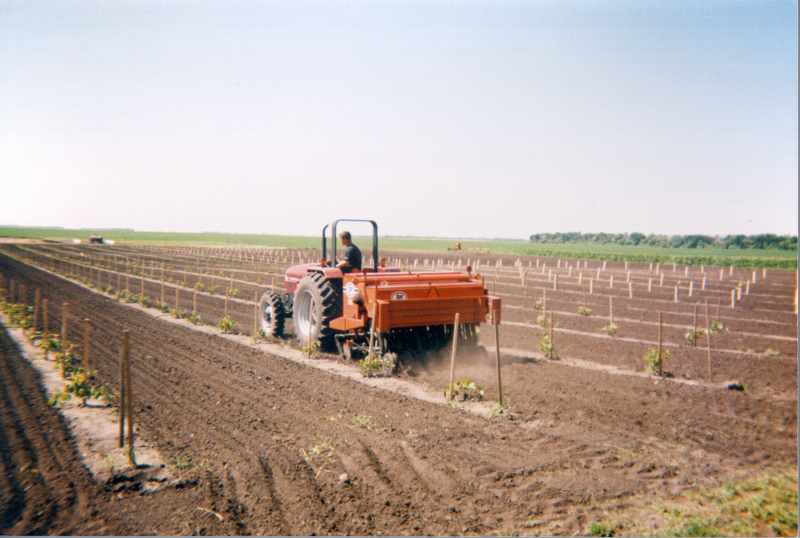
In the Spring of 2004, another 900 vines were planted,
consisting of eight different varieties:
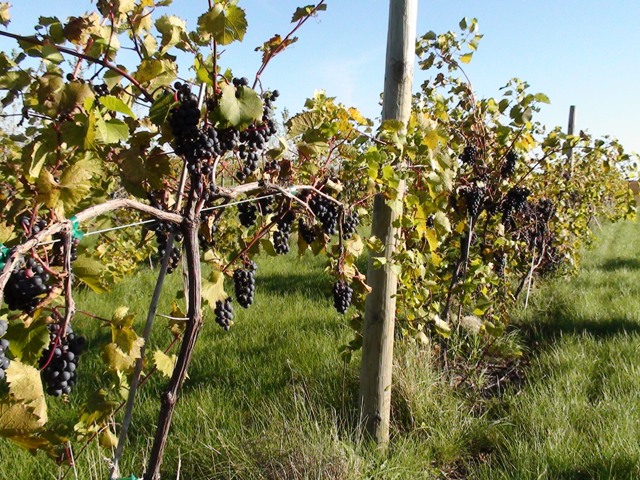
St Croix - Frontenac - Sabrevois - Somerset Seedless
St Pepin - Prairie Star - LaCrescent- Concord (Greece)
Most of these vines were for wine, but a few were for eating. The same pattern was followed of grass between the rows. Grow tubes were also placed on 300 vines, due to their tender young condition, until they would acclimate to the wind and the weather. Trellises were built for the 2003 vines, as well.
Also in 2004, it was decided that Red Trail Vineyard just might need a gathering place for the people who had been showing up to see what was going on at the Hogen Farmstead. Ever since our first planting in 2003, many people had stopped to check out first-hand the latest that they had heard, and some were even put to work before they had a chance to leave, doing planting and trellis work. So, a 100-year-old granary/bunkhouse was discovered near Casselton, ND and moved to a foundation at the Vineyard. It was later discovered that the site from which this building had been moved was also along the Old Red Trail, which was very appropriate. Work immediately began to convert this very old structure into a Tasting Room.
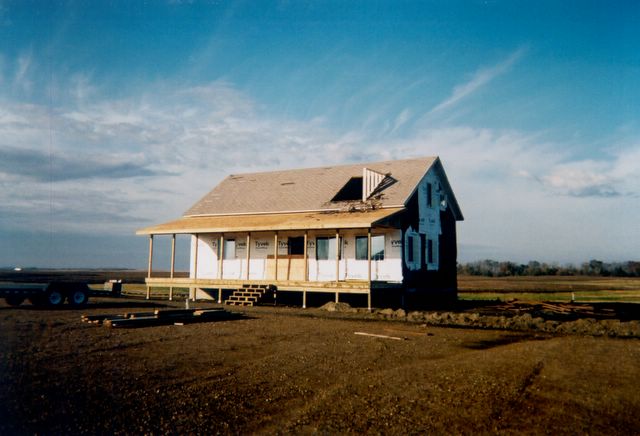
The Spring of 2005 brought with it more vines to be planted -- about 150 total of Louise Swenson. And there were some experimental varieties planted, too. Trellises were also constructed on the 2004 vines, so the days were quite busy. In late Spring, the Tasting Room was completed, and a Grand Opening was held to celebrate. There was some pomp involved with the ribbon-cutting ceremony, and speeches by Roger Johnson, North Dakota Agricultural Commissioner, by former First Lady of North Dakota, Nancy Schafer, and by officials of the City of Buffalo, and the owners. There was also a good measure of hometown hospitality, as people mingled and enjoyed themselves, in helping bring Red Trail Vineyard and its Tasting Room to life.
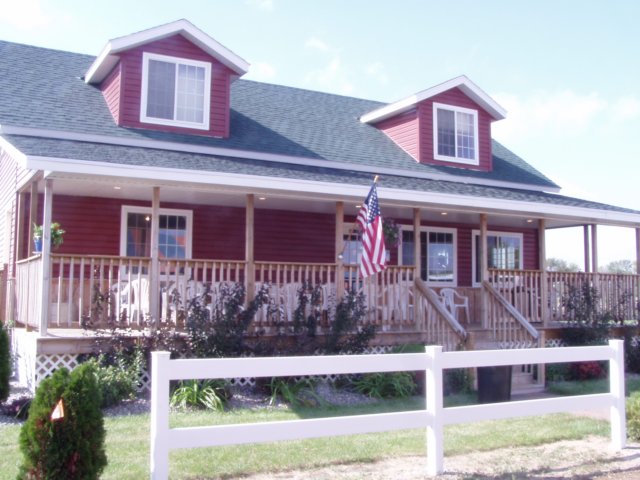
In September, the first harvest of the 2003 vines occurred. The production of third-year vines is typically very marginal, and this harvest produced only 19 bottles of wine. This first Red Trail Vineyard wine, named Alpha Rose, proved to be very popular. The entire stock was used for tasting only, so that more people could experience a wine produced from grapes grown in North Dakota.
2006 proved to be an eventful year, as well. More vines, again about 150, were planted, of two varieties:
Frontenac Gris Valiant
Red Trail Vineyard was selected as one of the research sites for North Dakota State University’s High Value Crop Program of their Horticulture Department, where different planting depths are being tested, and how plant growth and grape production might be influenced.
The second phase of the business of Red Trail Vineyard was well under way. Tours of the Vineyard occurred every week, and a number of large group meetings and events were hosted. The largest of these was the 1st annual North Dakota Wine and Grape Harvest Festival, held on September 16th. This was an event to help promote and celebrate the wine and grape industries in the state of North Dakota. The day was marked with continuous entertainment, including musical groups, games and trivia contests, caricature drawings, horse-drawn wagon rides, tours of the Vineyard, and the Grape Stomp.
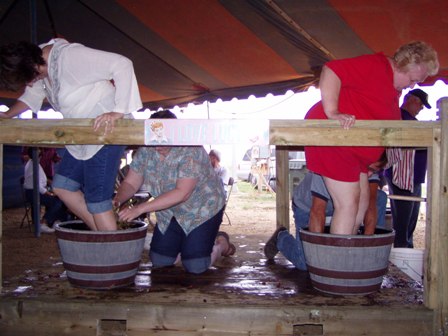
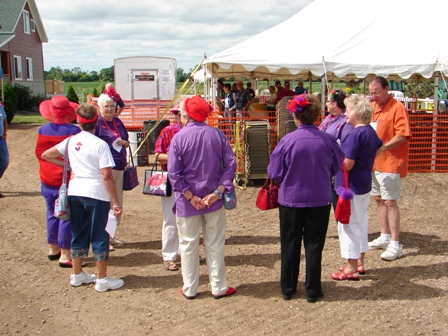
Harvest in 2006 proved to be quite different from the previous year. The vines used to produce Alpha Rose yielded ten-fold what they had the year before, and the St Croix vines, in their first year of production, nearly equaled that of the four-year-old vines. These grapes were processed into a wine by the same name, St Croix.
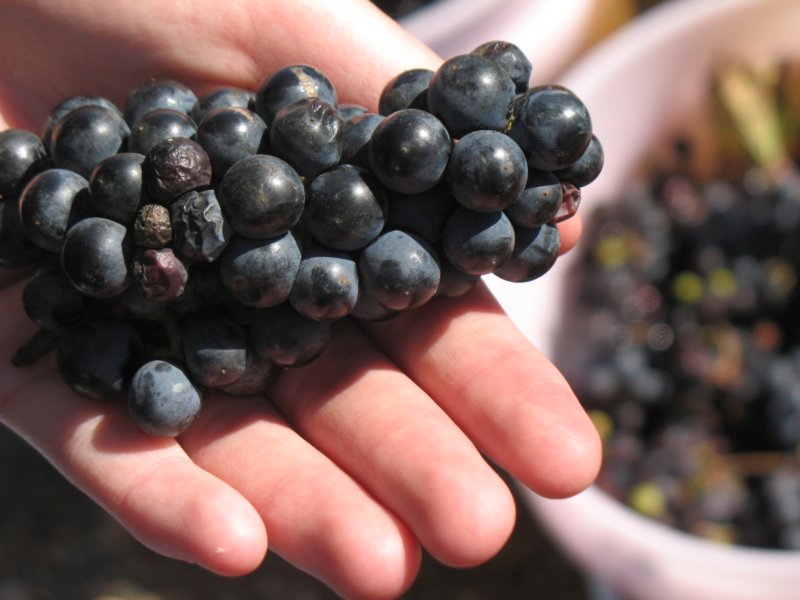
2007 began, just like previous years, busy, full of promise, and more plans and projects than there was time. The number of vines nearly doubled, with the planting of 1,260 more. These were of three varieties:
Frontenac Gris is a very prolific and well-proven white wine grape. Marquette, promising to be a very cold-hardy and disease-resistant red wine variety, is the newest release from the University of Minnesota. The St Croix vines, another red wine variety with a proven history for versatility and excellent tasting wine, were chosen to replace some other vines that 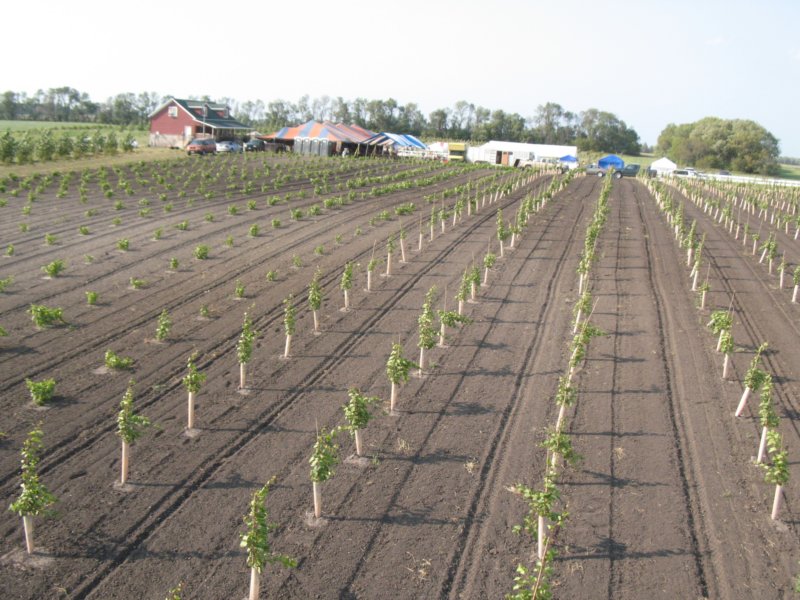 were lost. The Frontenac Gris and Marquette were planted in the expansion area, south of the Tasting Room (this is now referred to as the ‘South Vineyard’).
were lost. The Frontenac Gris and Marquette were planted in the expansion area, south of the Tasting Room (this is now referred to as the ‘South Vineyard’).
150 elderberry shrubs were also planted, in hope that when they mature, they will be able to be used to make wine as well. It is reported that elderberry has numerous healthful effects, and the wines made with elderberries that we have tasted have been excellent. Hopefully time will bring Red Trail Vineyard to that realization, too.
The other plans outlined for 2007 included continuing with the landscaping project, seemingly endless at this point, erecting the greenhouse which we moved in, in pieces, last autumn, and, of course, the annual North Dakota Wine and Grape Harvest Festival, scheduled August 25-26. The kitchen in the Tasting Room was commercially approved, so meals can now be prepared at the Vineyard for tours and events, rather than having them prepared off-site.
2008 will be the recipient of the wines produced from the 2007 crop. There are four new wines this year:
- Frontenac - a rich well-balanced semi-dry red wine, with a bright cherry nose and palate
- St Croix - a pleasant medium-bodied fruity wine
- Foch - a vibrant fruity taste and nose, with a hint of spice
- Red Trail White - a pleasing blend of a number of Cold-Climate grapes, displaying a fruity taste and aroma, and excellent finish
Red Trail Vineyard has planted numerous experimental vines in past years. One such experimental vine, developed by Tom Plocher, co-author of the book Northern Winework, describing detailed procedures in growing Cold-Climate Grapes, is very promising. This variety should be released in Canada soon, and to aid in the eventual release in the United States, Red Trail Vineyard is one of three sites in the United States testing this variety.
Red Trail Vineyard has enjoyed its early years of growth, as have many of the visitors who have joined us. We hope that you, too, will visit us soon, and experience the work-in-progress Vineyard, and wine produced from a North Dakota Vineyard.Our hours are Saturday 1-5 PM and Sunday 1-5 PM from Memorial Day weekend through September. We also realize that everyone is not on the same schedule and maybe a weekend visit does not fit into your plans. That’s okay. You are welcome to visit during the week, too. We just ask that you call or e-mail first to make sure that the day you are planning to visit isn’t the same day that we were planning to leave to get supplies, etc. Many of the special events at Red Trail Vineyard are planned during the week, and if you have a group of people who will accompany you here, it makes for a nice private party.
We, again, are offering tours and wine-tasting, a venue for small and large groups for gatherings, celebrations and meetings, and North Dakota wine, by the glass and the bottle. Remember, snacks, lunches and meals can also be included in your plans.
We are very excited and proud of our Vineyard, and we think you will be, too, and we look forward to your visit!
See you at the Vineyard!
Rodney & Susan Hogen and Family
